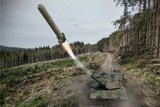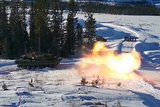EAPS successfully conducts MHTK guided test flight
Lockheed Martin has announced that the Extended Area Protection and Survivability (EAPS) programme has reached a significant milestone, with the successful completion of the first guided test flight to characterise the seeker, guidance, navigation and control systems of its Miniature Hit-to-Kill (MHTK) interceptor. This is the latest achievement in a series of events completed under the EAPS Integrated Demonstration Science and Technology programme.
The very small and agile MHTK interceptor is designed to defeat Rocket, Artillery and Mortar (RAM) targets at ranges greatly exceeding those of current systems.
The test, conducted on 22 March in collaboration with the US Army RDECOM/AMRDEC, saw the close replication of a tactical situation in which an enemy launches a mortar at an area protected by the MHTK intercept system. A radar successfully detected and tracked the threat in flight, and the tactically configured MHTK interceptor launched vertically and flew a trajectory positioning it to detect energy from a ground illuminator reflected off the mortar target. Responding to the reflected energy, the MHTK interceptor manoeuvred to fly very close to the target and gather data through its seeker as it passed the mortar in flight. Intercepting the target was not an objective of this flight test.
According to the company, in addition to gathering data to characterise the interceptor's performance, this test integrated and exercised the entire intercept system for the first time. The data collected will support an intercept flight test planned for later this year.
Loretta Painter, AMRDEC EAPS program director, said: ‘This guided flight represents progress for the programme. The data collected is an important step toward our goal of providing improved indirect fire protection capability. We are very pleased with the initial review of the test data and this data will be extremely valuable in reducing risks and making necessary improvements prior to the next flight.’
Mike Trotsky, vice president of Air & Missile Defense at Lockheed Martin Missiles and Fire Control, added: ‘We continue to successfully demonstrate the MHTK intercept capability with our EAPS solution. We are confident the system will play a crucial role in the affordable and effective protection of our forces in the future.’
At less than 1m long, less than 50mm in diameter and less than 3kg mass at launch, the MHTK is extremely compact and very agile in flight. Paired with a fire control sensor capable of providing illumination, the MHTK provides robust defeat of RAM targets through body-to-body impact at tactically significant ranges, greatly increasing the protected volume in which warfighters operate and offering commanders more flexibility than legacy and interim systems.
More from Land Warfare
-
![Germany signs multi-billion-dollar deals for 6x6 CAVS and GDELS Eagle vehicles]()
Germany signs multi-billion-dollar deals for 6x6 CAVS and GDELS Eagle vehicles
The order is a further boost for the Common Armoured Vehicles System programme which has notched notable successes in the past 12 months. The first vehicle, made in Finland, will be delivered next year with local production expected to ramp up in 2027.
-
![Rheinmetall and KNDS tank tie-up narrows trans-European options]()
Rheinmetall and KNDS tank tie-up narrows trans-European options
The French and German governments signed an agreement in June 2018 to cooperate on the development of a new main battle tank under the Main Ground Combat System programme but the effort has struggled. This new agreement may damage it further.
-
![2025 land market review: British Army woes, European heavy armour and US MBT progress]()
2025 land market review: British Army woes, European heavy armour and US MBT progress
The last year has seen several major procurements in the land market. Shephard’s Dr Peter Magill reviews the main trends and themes in land procurement of 2025.





















